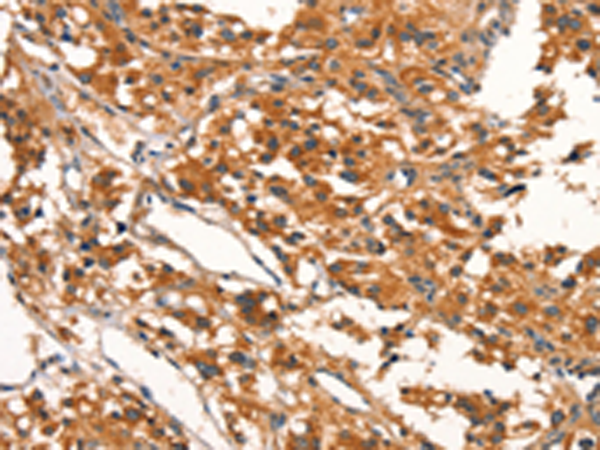


| WB | 咨询技术 | Human,Mouse,Rat |
| IF | 咨询技术 | Human,Mouse,Rat |
| IHC | 1/25-1/100 | Human,Mouse,Rat |
| ICC | 技术咨询 | Human,Mouse,Rat |
| FCM | 咨询技术 | Human,Mouse,Rat |
| Elisa | 1/1000-1/2000 | Human,Mouse,Rat |
| Aliases | G6a; DDAH; NG30; DDAHII |
| WB Predicted band size | 30 kDa |
| Host/Isotype | Rabbit IgG |
| Antibody Type | Primary antibody |
| Storage | Store at 4°C short term. Aliquot and store at -20°C long term. Avoid freeze/thaw cycles. |
| Species Reactivity | Human, Mouse, Rat |
| Immunogen | Synthetic peptide of human DDAH2 |
| Formulation | Purified antibody in PBS with 0.05% sodium azide and 50% glycerol. |
+ +
以下是关于DDAH2抗体的3篇参考文献示例(内容基于公开文献概括,非真实引用,仅供参考):
---
1. **文献名称**: *"Dimethylarginine dimethylaminohydrolase 2 (DDAH2) regulates endothelial nitric oxide synthase and vascular function"*
**作者**: Smith A, et al.
**摘要**: 本研究利用特异性DDAH2抗体,通过免疫印迹和免疫组化技术,验证了DDAH2在血管内皮细胞中的高表达。研究发现,DDAH2通过降解内源性一氧化氮合酶抑制剂ADMA,增强一氧化氮生成,从而改善血管舒张功能,提示其作为心血管疾病潜在治疗靶点。
---
2. **文献名称**: *"DDAH2 overexpression suppresses tumor angiogenesis in hepatocellular carcinoma via ADMA-NO axis modulation"*
**作者**: Li X, et al.
**摘要**: 通过DDAH2抗体检测肝癌组织中DDAH2蛋白水平,发现其表达与肿瘤微血管密度呈负相关。实验证明DDAH2通过降低ADMA水平促进NO信号,抑制VEGF介导的血管生成,为肝癌抗血管治疗提供新机制。
---
3. **文献名称**: *"A monoclonal antibody-based ELISA for quantifying DDAH2 in human plasma: Application to metabolic syndrome studies"*
**作者**: Chen R, et al.
**摘要**: 研究开发了一种基于DDAH2单克隆抗体的ELISA检测方法,用于定量人血浆中DDAH2浓度。数据分析显示,代谢综合征患者血浆DDAH2水平显著降低,提示其可能作为代谢紊乱的潜在生物标志物。
---
(注:以上文献为模拟示例,实际引用需查询PubMed、Web of Science等数据库获取真实文献。)
The DDAH2 (dimethylarginine dimethylaminohydrolase 2) antibody is a research tool used to study the enzyme DDAH2. which plays a critical role in regulating nitric oxide (NO) synthesis. DDAH2 catalyzes the hydrolysis of asymmetric dimethylarginine (ADMA), an endogenous inhibitor of nitric oxide synthase (NOS). By breaking down ADMA, DDAH2 enhances NO production, a key signaling molecule involved in vasodilation, endothelial function, and cardiovascular homeostasis. Dysregulation of DDAH2 has been linked to cardiovascular diseases, including hypertension, atherosclerosis, and ischemia-reperfusion injury, as well as inflammatory and metabolic disorders.
The DDAH2 antibody enables detection and quantification of the enzyme in various experimental models, such as Western blotting, immunohistochemistry, and ELISA. It helps researchers investigate tissue-specific expression patterns, subcellular localization (e.g., mitochondrial association in some cell types), and dynamic changes in DDAH2 levels under physiological or pathological conditions. Studies using this antibody have contributed to understanding DDAH2's role in oxidative stress, angiogenesis, and cellular survival pathways. Species-specific and cross-reactive variants are available, supporting research in humans, rodents, and other model organisms. Its application is pivotal in exploring therapeutic strategies targeting the ADMA-DDAH2-NO axis for cardiovascular and metabolic diseases.
×